tow Seat Alhambra 2006 Service Manual
[x] Cancel search | Manufacturer: SEAT, Model Year: 2006, Model line: Alhambra, Model: Seat Alhambra 2006Pages: 299, PDF Size: 6.33 MB
Page 150 of 299

Seats and stowage 148
•Damage to the vehicle caused by incorrect installation of mounts or roof
carrier systems not approved by the factory are excluded from the vehicle
warranty.
Securing the load
Loads transported on the roof carrier must be securely
attached. The car's handling is affected when transporting
loads.
The maximum permissible roof load for your vehicle is 75 kg. The load limit
applies to the combined weight of the carrier system and the load itself.
Distribute the load evenly. However, if you are using a roof carrier with a lower
weight rating, you will not be able to carry the maximum roof load. Do not
exceed the maximum weight limit for the roof carrier which is listed in the
fitting instructions.
WARNING
•If damaged, fine or inadequate securing straps are used to fasten
objects carried on the roof, they could break in the event of sharp braking.
This could cause an accident and serious injury.
•Always use appropriate securing straps to secure objects on the roof
carrier against sliding or flying off. This could cause an accident. The load
must be correctly secured.
•Always respect the maximum authorised weight for the roof, the
maximum authorised weight on the axles and the total maximum author-
ised weight of the vehicle. Otherwise there is danger of causing an acci-
dent.
•The risk of an accident is increased by transporting heavy or bulky
loads on the roof, which affects the car's handling by shifting the centre of
gravity and increasing susceptibility to cross winds. Both circumstances increase the risk of accident. Therefore you must adapt your driving style
and speed to the prevailing conditions - avoid sudden braking or driving
manoeuvres when there is a load on the roof carrier.
Caution
Please take extra care not to let the tailgate or rear window strike the roof load
when open – there is a risk of damage to the vehicle.
For the sake of the environment
The roof carrier is often left on the roof for convenience even if it is not being
used. However, increased air resistance means that the vehicle uses more
fuel. For this reason you should always take off the roof carrier when it is not
in use.
Cooling and heating box*
Notes on usage
The cooling and heating box may only be installed in the posi-
tion of rear left seat in the third row.
Power can be supplied by any of the 12 Volt sockets in the vehicle. It
consumes approximately 33 watts and has a capacity of approximately
32 litres.
The battery will discharge if the cooling and heating box is used for a long
period while the engine is switched off.
WARNING (continued)
Page 151 of 299

Seats and stowage149
Safety FirstOperating instructionsTips and MaintenanceTe c h n i c a l D a t a Before using the cooling and heating box for the first time, you should clean
it using a household detergent.
Disconnect the power supply and clean the box if you do not plan to use the
cooling and heating box for a long period. Place a folded towel between the
box and its lid. This prevents mould and damp stains forming in the cooling
and heating box.
Whenever possible, food and drinks should be stored in air-tight containers
in the box.
Do not overfill the box - this would prevent air circulation within the box.
Place crumpled paper (or similar) between bottles and other containers in the
box to prevent clanking noises.
Do not fill the interior of the box with liquid or ice.
Caution
•Do not place objects, blankets, or clothes on top of the cooling/heating
box, as the air intake and output may be obstructed and the box will discon-
nect itself.
•Do not place any containers, food items or other objects into the box if
they are warmer than +50°C. This could damage the cooling and heating box.
•The cold/hot box is not suitable for transporting corrosive material or
material containing solvents.
•Never leave the cold/hot box in the rain or damp.
Note
•The cooling and heating box is not designed to heat or cool the interior of
the vehicle. The cooling and heating box should be used only for cooling and
warming food and drinks and for transporting heat-sensitive items on short
journeys.
•A corresponding manual for the installation and use of the cooling and
heating box is included by the manufacturer and should be kept with the
vehicle wallet.
Cooling or heating
The contents of the cooling and heating box can be cooled or
kept warm.
Switching on the cooling function
– Insert the cable plug in the cooling and heating box so that the
blue marking on the plug is pointing to the notch.
– Insert the connector cable plug into one of the vehicle's 12 volt
sockets.
– Keep the lid of the cooling and heating box closed.
Fig. 117 Cooling and
heating box as installed
Page 152 of 299
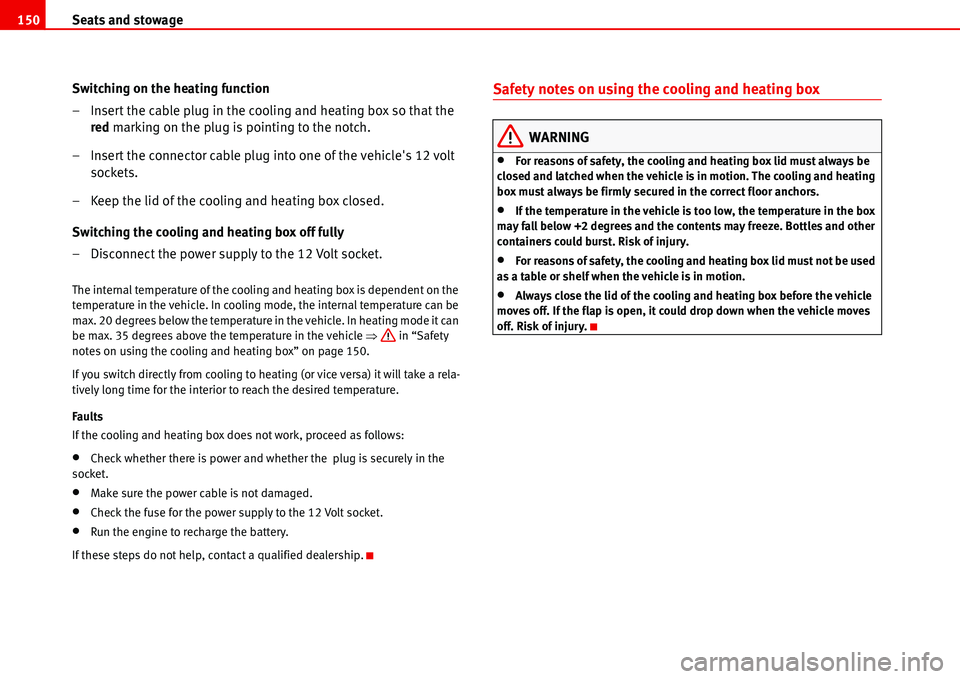
Seats and stowage 150
Switching on the heating function
– Insert the cable plug in the cooling and heating box so that the
red marking on the plug is pointing to the notch.
– Insert the connector cable plug into one of the vehicle's 12 volt
sockets.
– Keep the lid of the cooling and heating box closed.
Switching the cooling and heating box off fully
– Disconnect the power supply to the 12 Volt socket.
The internal temperature of the cooling and heating box is dependent on the
temperature in the vehicle. In cooling mode, the internal temperature can be
max. 20 degrees below the temperature in the vehicle. In heating mode it can
be max. 35 degrees above the temperature in the vehicle �Ÿ in “Safety
notes on using the cooling and heating box” on page 150.
If you switch directly from cooling to heating (or vice versa) it will take a rela-
tively long time for the interior to reach the desired temperature.
Faults
If the cooling and heating box does not work, proceed as follows:
•Check whether there is power and whether the plug is securely in the
socket.
•Make sure the power cable is not damaged.
•Check the fuse for the power supply to the 12 Volt socket.
•Run the engine to recharge the battery.
If these steps do not help, contact a qualified dealership.
Safety notes on using the cooling and heating box
WARNING
•For reasons of safety, the cooling and heating box lid must always be
closed and latched when the vehicle is in motion. The cooling and heating
box must always be firmly secured in the correct floor anchors.
•If the temperature in the vehicle is too low, the temperature in the box
may fall below +2 degrees and the contents may freeze. Bottles and other
containers could burst. Risk of injury.
•For reasons of safety, the cooling and heating box lid must not be used
as a table or shelf when the vehicle is in motion.
•Always close the lid of the cooling and heating box before the vehicle
moves off. If the flap is open, it could drop down when the vehicle moves
off. Risk of injury.
Page 159 of 299

Heating, Ventilation and Air conditioning157
Safety FirstOperating instructionsTips and MaintenanceTe c h n i c a l D a t a Air vents in the roof
In vehicles with a second cooling system
39) for ventilating the passenger
compartment, an air outlet is fitted in the roof above each rear seat
�Ÿfig. 122.
The air outlets in the roof can be opened and closed individually and
adjusted by moving the grid.
Each air outlet has two thumb wheels. The left thumb wheel can be used to
open and close the air outlet. The right thumb wheel can be used to direct the
air towards the head and chest.
WARNING
Never leave objects, food or medicines in front of the air outlets in the rear
seats. The hot air could damage or destroy heat-sensitive objects, food or
medicines.
Caution
Do not use the area in front of the outlets to store objects. This could cause
the blower to overheat and switch off. The blower could also be damaged.
Note
In the cooling mode, at least one air outlet in the roof must be open. The
cooling system could otherwise ice over.
General notes
The pollen filter
The pollution filter serves as a barrier against impurities in the ambient air
(e.g. dust and pollen).
For the air conditioning system to work with maximum efficiency, the pollen
filter must be replaced at the intervals specified in the Service Schedule.
If the filter loses efficiency prematurely due to use in areas with very high
levels of air pollution, the pollen filter must be changed more frequently than
stated in the Service Schedule.
Instructions for use
If the air conditioning or Climatronic
40) is not switched on for a long period,
deposits on the evaporator can cause unpleasant smells. To prevent these
odours, the cooling system should be run at the highest blower setting at
least once a month when temperatures are over +5°C. Briefly open a window
at the same time.
Faults in the operation of the air conditioning
There is a fault if the all the symbols in the Climatronic flash for approx. 15
seconds when the ignition is switched on. Contact a specialist workshop.
If the air conditioning system cannot be switched on this may be caused by
the following reasons:
•the engine is not running.
•The blower is switched off.
•The outside temperature is lower than +5°C.
•the cooling system compressor has been temporarily switched off
because the engine coolant temperature is too high.
•The air conditioner fuse is faulty.
39)Optional equipment40)Optional equipment
Page 162 of 299
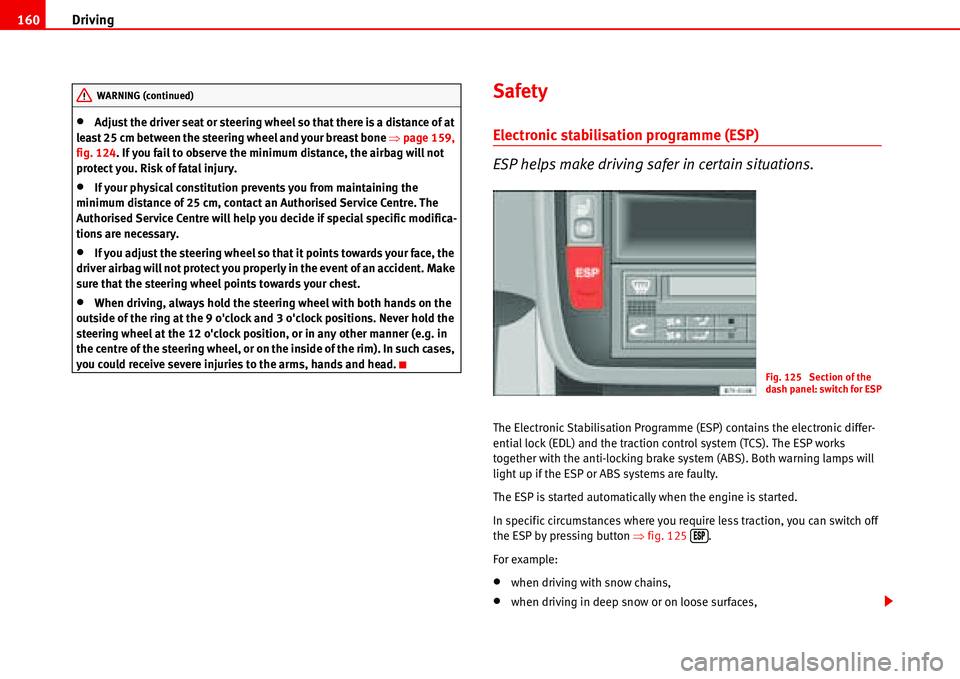
Driving 160
•Adjust the driver seat or steering wheel so that there is a distance of at
least 25 cm between the steering wheel and your breast bone �Ÿpage 159,
fig. 124. If you fail to observe the minimum distance, the airbag will not
protect you. Risk of fatal injury.
•If your physical constitution prevents you from maintaining the
minimum distance of 25 cm, contact an Authorised Service Centre. The
Authorised Service Centre will help you decide if special specific modifica-
tions are necessary.
•If you adjust the steering wheel so that it points towards your face, the
driver airbag will not protect you properly in the event of an accident. Make
sure that the steering wheel points towards your chest.
•When driving, always hold the steering wheel with both hands on the
outside of the ring at the 9 o'clock and 3 o'clock positions. Never hold the
steering wheel at the 12 o'clock position, or in any other manner (e.g. in
the centre of the steering wheel, or on the inside of the rim). In such cases,
you could receive severe injuries to the arms, hands and head.
Safety
Electronic stabilisation programme (ESP)
ESP helps make driving safer in certain situations.
The Electronic Stabilisation Programme (ESP) contains the electronic differ-
ential lock (EDL) and the traction control system (TCS). The ESP works
together with the anti-locking brake system (ABS). Both warning lamps will
light up if the ESP or ABS systems are faulty.
The ESP is started automatically when the engine is started.
In specific circumstances where you require less traction, you can switch off
the ESP by pressing button �Ÿfig. 125 .
For example:
•when driving with snow chains,
•when driving in deep snow or on loose surfaces,
WARNING (continued)
Fig. 125 Section of the
dash panel: switch for ESP
�%�3�0
Page 163 of 299

Driving161
Safety FirstOperating instructionsTips and MaintenanceTe c h n i c a l D a t a
•when rocking the vehicle backwards and forwards to free it from mud, for
example.
You should press the button to switch the ESP back on when you no longer
need wheel spin.
The TCS and EDL are also switched off if the ESP is switched off. This means
that this technology is not available for as long as the ESP remains switched
off.
When does the inscription OFF light up on the button?
•It will light up continuously if there is a malfunction in the ESP.
•It will light up continuously if the ESP is switched off.
WARNING
•The electronic stabilisation program (ESP) cannot defy the laws of
physics. This should be kept in mind, particularly on slippery and wet
roads and when towing a trailer.
•Always adapt your driving style to suit the condition of the roads and
the traffic situation. Do not let the extra safety afforded by ESP tempt you
into taking any risks when driving, this can cause accidents.
•Please refer to the corresponding warning notes on ESP.
Ignition lock
Position of the ignition key
Ignition switched off, steering lock
In position �Ÿfig. 126 the ignition is switched off, and the steering wheel
lock can be engaged.
To engage the steering wheel lock, take out the key and turn the wheel
slightly until you hear the pin engage. You should always lock the steering
wheel when you leave your vehicle. This makes vehicle theft more difficult
�Ÿ.
Switching on the ignition or glow plug system
Tu rn the ignition key to this position and let go of the key. If the key canno t b e
turned or is difficult to turn from position to position , move the
steering wheel (to take the load off the steering lock mechanism) until the key
turns freely.
ESP
Fig. 126 Ignition key
positions
A1
A1
A2
A1A2
Page 165 of 299
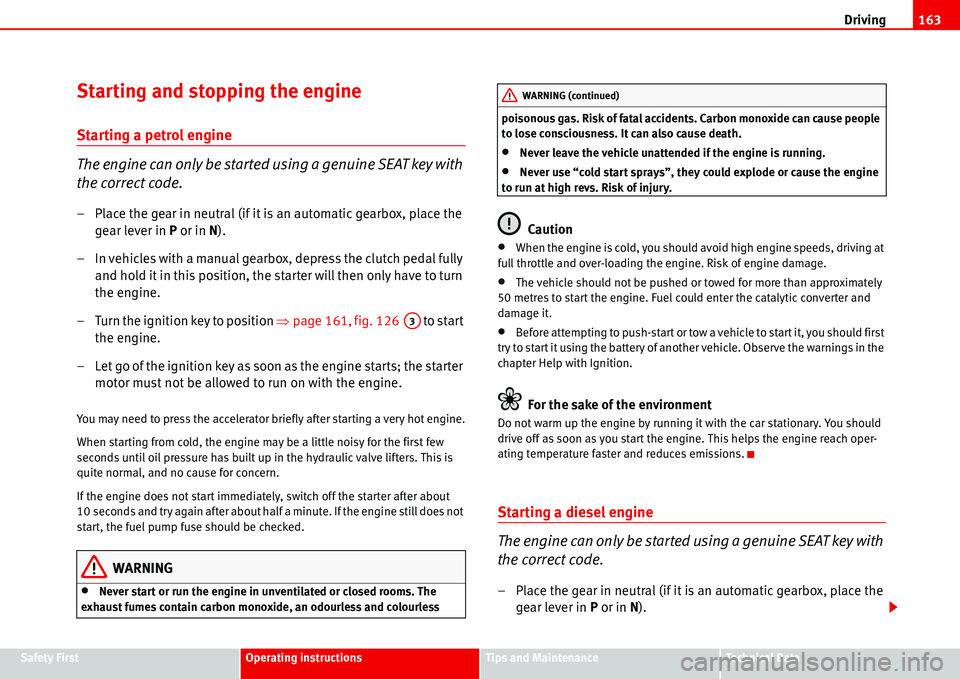
Driving163
Safety FirstOperating instructionsTips and MaintenanceTe c h n i c a l D a t a
Starting and stopping the engine
Starting a petrol engine
The engine can only be started using a genuine SEAT key with
the correct code.
– Place the gear in neutral (if it is an automatic gearbox, place the
gear lever in P or in N).
– In vehicles with a manual gearbox, depress the clutch pedal fully
and hold it in this position, the starter will then only have to turn
the engine.
– Turn the ignition key to position �Ÿpage 161, fig. 126 to start
the engine.
– Let go of the ignition key as soon as the engine starts; the starter
motor must not be allowed to run on with the engine.
You may need to press the accelerator briefly after starting a very hot engine.
When starting from cold, the engine may be a little noisy for the first few
seconds until oil pressure has built up in the hydraulic valve lifters. This is
quite normal, and no cause for concern.
If the engine does not start immediately, switch off the starter after about
10 seconds and try again after about half a minute. If the engine still does not
start, the fuel pump fuse should be checked.
WARNING
•Never start or run the engine in unventilated or closed rooms. The
exhaust fumes contain carbon monoxide, an odourless and colourless poisonous gas. Risk of fatal accidents. Carbon monoxide can cause people
to lose consciousness. It can also cause death.
•Never leave the vehicle unattended if the engine is running.
•Never use “cold start sprays”, they could explode or cause the engine
to run at high revs. Risk of injury.
Caution
•When the engine is cold, you should avoid high engine speeds, driving at
full throttle and over-loading the engine. Risk of engine damage.
•The vehicle should not be pushed or towed for more than approximately
50 metres to start the engine. Fuel could enter the catalytic converter and
damage it.
•Before attempting to push-start or tow a vehicle to start it, you should first
try to start it using the battery of another vehicle. Observe the warnings in the
chapter Help with Ignition.
For the sake of the environment
Do not warm up the engine by running it with the car stationary. You should
drive off as soon as you start the engine. This helps the engine reach oper-
ating temperature faster and reduces emissions.
Starting a diesel engine
The engine can only be started using a genuine SEAT key with
the correct code.
– Place the gear in neutral (if it is an automatic gearbox, place the
gear lever in P or in N).
A3
WARNING (continued)
Page 166 of 299

Driving 164
– In vehicles with a manual gearbox, depress the clutch pedal fully
and hold it in this position, the starter will then only have to turn
the engine.
– Turn the ignition key to position �Ÿpage 161, fig. 126 . The
warning lamp
�D lights up to show that the glow plugs are
preheating the engine.
– When the warning lamp goes out, turn the key to position to
start the engine. Do not press the accelerator.
– Let go of the ignition key as soon as the engine starts, the starter
motor must not be allowed to run on with the engine.
When starting from cold, the engine may be a little noisy for the first few
seconds until oil pressure has built up in the hydraulic valve lifters. This is
quite normal, and no cause for concern.
If you have problems starting the engine, please refer to Help with Ignition.
Glow plug system
To avoid unnecessary loads on the battery, do not use any other major elec-
trical equipment while the glow plugs are preheating.
Start the engine as soon as the glow plug warning lamp goes out.
Starting a diesel engine after the fuel tank has been completely run dry
If the fuel tank has been completely run dry, it may take longer than normal
(up to one minute) to start a diesel engine after refuelling. This is because air
needs to be bled from the fuel system while starting.
WARNING
•Never start or run the engine in unventilated or closed rooms. The
exhaust fumes contain carbon monoxide, an odourless and colourless poisonous gas. Risk of fatal accidents. Carbon monoxide can cause people
to lose consciousness. It can also cause death.
•Never leave the vehicle unattended if the engine is running.
•Never use “cold start sprays”, they could explode or cause the engine
to run at high revs. Risk of injury.
Caution
•When the engine is cold, you should avoid high engine speeds, driving at
full throttle and over-loading the engine. Risk of engine damage.
•The vehicle should not be pushed or towed for more than approximately
50 metres to start the engine. Fuel could enter the catalytic converter and
damage it.
•Before attempting to push-start or tow a vehicle to start it, you should first
try to start it using the battery of another vehicle. Observe the warnings in the
chapter Help with Ignition.
For the sake of the environment
Do not warm up the engine by running it with the car stationary. You should
drive off as soon as you start the engine. This helps the engine reach oper-
ating temperature faster and reduces emissions.
Switching off the engine
– Stopping the engine.
– Turn the ignition key to position �Ÿpage 161, fig. 126 .
A2
A3
WARNING (continued)
A1
Page 175 of 299
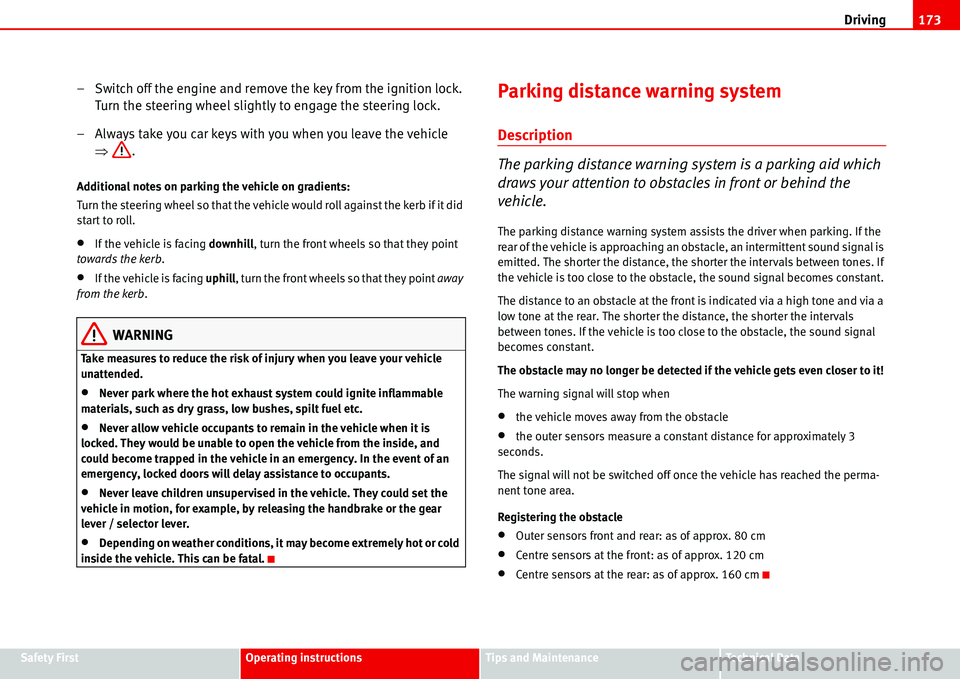
Driving173
Safety FirstOperating instructionsTips and MaintenanceTe c h n i c a l D a t a
– Switch off the engine and remove the key from the ignition lock.
Turn the steering wheel slightly to engage the steering lock.
– Always take you car keys with you when you leave the vehicle
�Ÿ.
Additional notes on parking the vehicle on gradients:
Turn the steering wheel so that the vehicle would roll against the kerb if it did
start to roll.
•If the vehicle is facing downhill, turn the front wheels so that they point
towards the kerb.
•If the vehicle is facing uphill, turn the front wheels so that they point away
from the kerb.
WARNING
Take measures to reduce the risk of injury when you leave your vehicle
unattended.
•Never park where the hot exhaust system could ignite inflammable
materials, such as dry grass, low bushes, spilt fuel etc.
•Never allow vehicle occupants to remain in the vehicle when it is
locked. They would be unable to open the vehicle from the inside, and
could become trapped in the vehicle in an emergency. In the event of an
emergency, locked doors will delay assistance to occupants.
•Never leave children unsupervised in the vehicle. They could set the
vehicle in motion, for example, by releasing the handbrake or the gear
lever / selector lever.
•Depending on weather conditions, it may become extremely hot or cold
inside the vehicle. This can be fatal.
Parking distance warning system
Description
The parking distance warning system is a parking aid which
draws your attention to obstacles in front or behind the
vehicle.
The parking distance warning system assists the driver when parking. If the
rear of the vehicle is approaching an obstacle, an intermittent sound signal is
emitted. The shorter the distance, the shorter the intervals between tones. If
the vehicle is too close to the obstacle, the sound signal becomes constant.
The distance to an obstacle at the front is indicated via a high tone and via a
low tone at the rear. The shorter the distance, the shorter the intervals
between tones. If the vehicle is too close to the obstacle, the sound signal
becomes constant.
The obstacle may no longer be detected if the vehicle gets even closer to it!
The warning signal will stop when
•the vehicle moves away from the obstacle
•the outer sensors measure a constant distance for approximately 3
seconds.
The signal will not be switched off once the vehicle has reached the perma-
nent tone area.
Registering the obstacle
•Outer sensors front and rear: as of approx. 80 cm
•Centre sensors at the front: as of approx. 120 cm
•Centre sensors at the rear: as of approx. 160 cm
Page 176 of 299
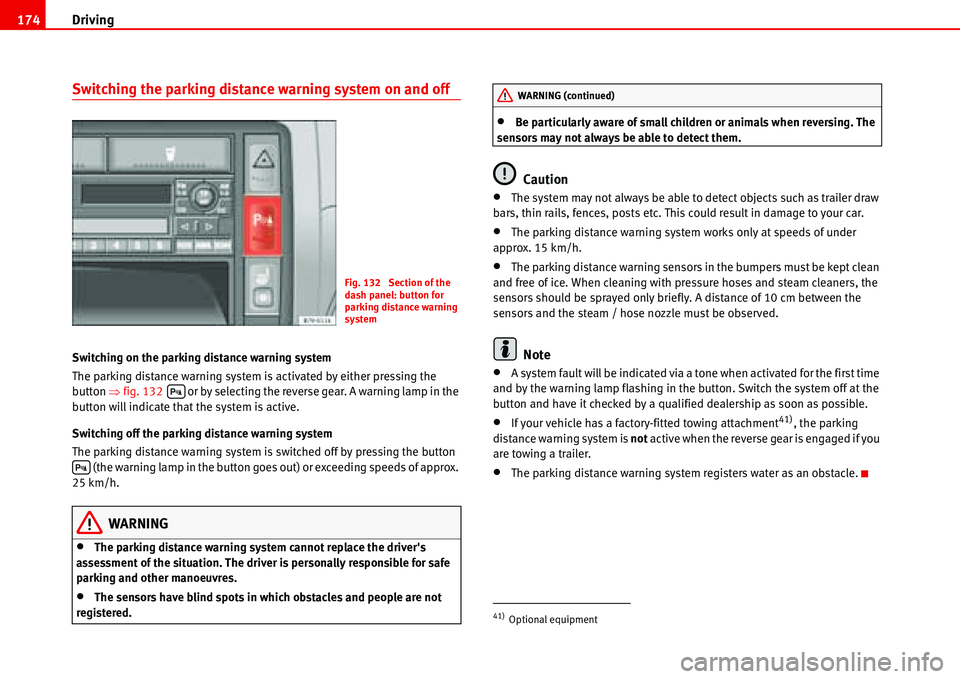
Driving 174
Switching the parking distance warning system on and off
Switching on the parking distance warning system
The parking distance warning system is activated by either pressing the
button �Ÿfig. 132 or by selecting the reverse gear. A warning lamp in the
button will indicate that the system is active.
Switching off the parking distance warning system
The parking distance warning system is switched off by pressing the button
(the warning lamp in the button goes out) or exceeding speeds of approx.
25 km/h.
WARNING
•The parking distance warning system cannot replace the driver's
assessment of the situation. The driver is personally responsible for safe
parking and other manoeuvres.
•The sensors have blind spots in which obstacles and people are not
registered.
•Be particularly aware of small children or animals when reversing. The
sensors may not always be able to detect them.
Caution
•The system may not always be able to detect objects such as trailer draw
bars, thin rails, fences, posts etc. This could result in damage to your car.
•The parking distance warning system works only at speeds of under
approx. 15 km/h.
•The parking distance warning sensors in the bumpers must be kept clean
and free of ice. When cleaning with pressure hoses and steam cleaners, the
sensors should be sprayed only briefly. A distance of 10 cm between the
sensors and the steam / hose nozzle must be observed.
Note
•A system fault will be indicated via a tone when activated for the first time
and by the warning lamp flashing in the button. Switch the system off at the
button and have it checked by a qualified dealership as soon as possible.
•If your vehicle has a factory-fitted towing attachment41), the parking
distance warning system is not active when the reverse gear is engaged if you
are towing a trailer.
•The parking distance warning system registers water as an obstacle.
Fig. 132 Section of the
dash panel: button for
parking distance warning
system
�'
�'
41)Optional equipment
WARNING (continued)